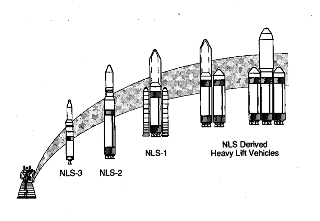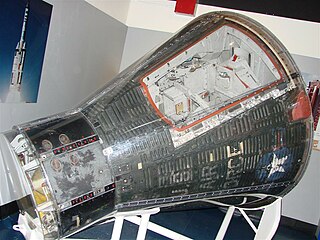Related Research Articles

A reusable launch vehicle has parts that can be recovered and reflown, while carrying payloads from the surface to outer space. Rocket stages are the most common launch vehicle parts aimed for reuse. Smaller parts such as rocket engines and boosters can also be reused, though reusable spacecraft may be launched on top of an expendable launch vehicle. Reusable launch vehicles do not need to make these parts for each launch, therefore reducing its launch cost significantly. However, these benefits are diminished by the cost of recovery and refurbishment.

A spaceplane is a vehicle that can fly and glide like an aircraft in Earth's atmosphere and maneuver like a spacecraft in outer space. To do so, spaceplanes must incorporate features of both aircraft and spacecraft. Orbital spaceplanes tend to be more similar to conventional spacecraft, while sub-orbital spaceplanes tend to be more similar to fixed-wing aircraft. All spaceplanes to date have been rocket-powered for takeoff and climb, but have then landed as unpowered gliders.

The Lockheed Martin X-33 was a proposed uncrewed, sub-scale technology demonstrator suborbital spaceplane that was developed for a period in the 1990s. The X-33 was a technology demonstrator for the VentureStar orbital spaceplane, which was planned to be a next-generation, commercially operated reusable launch vehicle. The X-33 would flight-test a range of technologies that NASA believed it needed for single-stage-to-orbit reusable launch vehicles, such as metallic thermal protection systems, composite cryogenic fuel tanks for liquid hydrogen, the aerospike engine, autonomous (uncrewed) flight control, rapid flight turn-around times through streamlined operations, and its lifting body aerodynamics.

National Security Space Launch (NSSL) is a program of the United States Space Force (USSF) intended to assure access to space for United States Department of Defense and other United States government payloads. The program is managed by the Assured Access to Space Directorate (SSC/AA) of the Space Force's Space Systems Command (SSC), in partnership with the National Reconnaissance Office.

The Air Force Research Laboratory (AFRL) is a scientific research and development detachment of the United States Air Force Materiel Command dedicated to leading the discovery, development, and integration of direct-energy based aerospace warfighting technologies, planning and executing the Air Force science and technology program, and providing warfighting capabilities to United States air, space, and cyberspace forces. It controls the entire Air Force science and technology research budget which was $2.4 billion in 2006.

Titan IV was a family of heavy-lift space launch vehicles developed by Martin Marietta and operated by the United States Air Force from 1989 to 2005. Launches were conducted from Cape Canaveral Air Force Station, Florida and Vandenberg Air Force Base, California.
Hopper was a proposed European Space Agency (ESA) orbital spaceplane and reusable launch vehicle. The Hopper was a FESTIP system study design.

The DARPA FALCON Project is a two-part joint project between the Defense Advanced Research Projects Agency (DARPA) and the United States Air Force (USAF) and is part of Prompt Global Strike. The first part of the project aims to develop a Small Launch System (SLS) capable of accelerating hypersonic gliding weapons as well as launching small satellites into Earth orbit. The second part of the project aims to develop Hypersonic Weapon Systems (HWS): a short term high performance hypersonic gliding weapon previously named the X-41 Common Aero Vehicle (CAV) that could be launched from Expendable Launch Vehicles (ELV), Reusable Launch Vehicles (RLVs), Hypersonic Cruise Vehicles (HCV), or Space Maneuvering Vehicles (SMP), and a long term hypersonic cruise aircraft named the Hypersonic Cruise Vehicle (HCV). This two-part program was announced in 2003 and continued into 2006.

A modular rocket is a kind of multistage rocket which has components that can interchanged for different missions. Several such rockets use similar concepts such as unified modules to minimize expenses on manufacturing, transportation and for optimization of support infrastructure for flight preparations.

Atlas is a family of US missiles and space launch vehicles that originated with the SM-65 Atlas. The Atlas intercontinental ballistic missile (ICBM) program was initiated in the late 1950s under the Convair Division of General Dynamics. Atlas was a liquid propellant rocket burning RP-1 kerosene fuel with liquid oxygen in three engines configured in an unusual "stage-and-a-half" or "parallel staging" design: two outboard booster engines were jettisoned along with supporting structures during ascent, while the center sustainer engine, propellant tanks and other structural elements remained connected through propellant depletion and engine shutdown.

The Space Launch Initiative (SLI) was a NASA and U.S. Department of Defense joint research and technology project to determine the requirements to meet all the nation's hypersonics, space launch and space technology needs. It was also known as the second generation Reusable Launch Vehicle program, after the failure of the first. The program began with the award of RLV study contracts in 2000.

Demonstration and Science Experiments (DSX) was a small spacecraft developed by the U.S. Air Force Research Laboratory's Space Vehicles Directorate to perform experiments to study the radiation environment in medium Earth orbit.

The National Launch System was a study authorized in 1991 by President George H. W. Bush to outline alternatives to the Space Shuttle for access to Earth orbit. Shortly thereafter, NASA asked Lockheed Missiles and Space, McDonnell Douglas, and TRW to perform a ten-month study.

Reusable Launch Vehicle–Technology Demonstration Programme is a series of technology demonstration missions that has been conceived by the Indian Space Research Organisation (ISRO) as a first step towards realising a Two Stage To Orbit (TSTO) re-usable launch vehicle, in which the second stage is a spaceplane.
SpaceWorks Enterprises, Inc. (SEI) is an aerospace engineering company based in Atlanta, Georgia, United States that specializes in the design, assessment, hardware prototyping and flight demonstration of advanced space concepts for both government and commercial customers.
The EELV Secondary Payload Adapter (ESPA) is an adapter for launching secondary payloads on orbital launch vehicles.
Aircraft can have different ways to take off and land. Conventional airplanes accelerate along the ground until sufficient lift is generated for takeoff, and reverse the process to land. Some airplanes can take off at low speed, this being a short takeoff. Some aircraft such as helicopters and Harrier jump jets can take off and land vertically. Rockets also usually take off vertically, but some designs can land horizontally.
The DARPA XS-1 was an experimental spaceplane/booster with the planned capability to deliver small satellites into orbit for the U.S. Military. It was reported to be designed to be reusable as frequently as once a day, with a stated goal of doing so for 10 days straight. The XS-1 was intended to directly replace the first stage of a multistage rocket by taking off vertically and flying to hypersonic speed and high suborbital altitude, enabling one or more expendable upper stages to separate and deploy a payload into low Earth orbit. The XS-1 would then return to Earth, where it could ostensibly be serviced fast enough to repeat the process at least once every 24 hours.
Space Vector Corporation (SVC) is a United States-based company that provides aerospace products and services to government and commercial customers. Space Vector is headquartered in Chatsworth, California and is a privately held small business. Its primary products are flight safety and system batteries, GPS tracking systems, custom avionics and structures, attitude control systems, pneumatic components, and separation systems. Space Vector also provides launch services as a prime contractor under the Space and Missile Systems Center (SMC) Sounding Rocket Program (SRP-3) which includes performing vehicle integration activities, end-to-end system testing, payload integration, launch operations, and mission analysis and design.

Gemini SC-2 was the second NASA Project Gemini full-up reentry capsule built. This McDonnell Gemini capsule was the first space capsule to be reused, flying twice in suborbital flights. SC-2 flew on Gemini 2 and OPS 0855 flights. The capsule is currently on display at the Air Force Space and Missile Museum at Cape Canaveral Air Force Station.
References
- 1 2 3 Cogliano (March 22, 2011). "Air Force launches $250M reusable booster initiative". Dayton Business Journal. Retrieved March 24, 2011.
Officials anticipate awarding up to three contracts for the project, where winners would compete for individual tasks of experiments and demonstrations that address technology, processes and other attributes of a reusable booster system, or RBS. Air Force officials envision an RBS that includes a reusable rocket and an expendable upper stage rocket. The reusable rocket would have been launched vertically and return, landing aircraft style on a runway, after carrying the space craft to a point where the expendable rocket could take over.
- ↑ "Air Force studying reusable upper stage systems for reusable booster". RLV and Space Transport News. September 20, 2010. Archived from the original on July 24, 2011. Retrieved March 24, 2011.
- 1 2 3 4 Ferster, Warren (October 19, 2012). "Prototype Reusable Rocket Effort Felled by U.S. Budget Woes". Space News. Retrieved October 21, 2012.
- 1 2 Reusable Successor To EELV Moving Ahead April 23, 2012
- ↑ "Lockheed Martin Selected USAF for Reusable Booster System Flight Demonstrator Program". www.space-travel.com.
- ↑ "Reusable Successor to EELV Moving Ahead". Archived from the original on 2012-05-11. Retrieved 2022-07-16.
- ↑ Foust, Jeff (November 26, 2012). "What is the future of the RLV?". The Space Review.
- ↑ Reusable Booster System – Review and Assessment. The NRC 2012 report
- ↑ "TR 107 Main Engine" (Press release). January 2012.